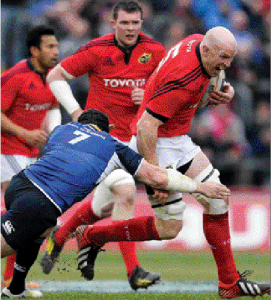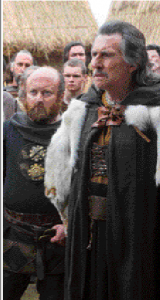SEEN
Published in Issue 2 (March/April 2014), Reviews, Volume 22Cluain Tarbh
Abú Media, TG4, Good Friday (18 April) 2014

The provincial dynamics of Irish history are illustrated with footage of a Leinster–Munster rugby match. (Sports News Ireland).
There is an unfortunate moment in the BBC/RTÉ co-production The story of Ireland (reviewed here in May/June 2011) when presenter Fergal Keane, whilst discussing Brian Boru, walks into Dublin City Hall, where ‘the legend of Brian is commemorated on the dome’. Keane stood, stared and nodded at the painting that presumably depicted Brian Boru, while his voiceover solemnly intoned that ‘in the telling of Ireland’s story he [Brian] would become an icon of native resistance, the first nationalist hero’. Alas, it would have been better for Keane, while making such a claim, to have stood beneath the right painting. The paintings in City Hall (designed just prior to the First World War by James Ward, headmaster of the Dublin Metropolitan School of Art) encapsulate themes such as the history of Dublin (as suggested by the Sinn Féin alderman Thomas Kelly) and the coming of Christianity, all imbued with a subtle (and non-sectarian) nationalistic undercurrent. Keane stood beneath Irishmen oppose the landing of the Viking fleet 841 AD, but he should really have pondered Brian Boru beneath the painting Brian Boru, High King of Ireland, addresses his army before the Battle of Clontarf, 1014 AD. It was an unfortunate error to make in a series that self-consciously set itself up as a slayer of myths. Yet this seemingly iconoclastic approach is taken by many documentaries, and the life and times of Brian Boru surely offer ripe material for debunking; as Clare O’Halloran shows in the current issue, he has been eulogised and mythologised virtually since he (supposedly) met his end at the hands of the Viking Bródar on Good Friday 1014. TV documentaries can, and often do, loudly proclaim how they will bust myths to reveal a hidden truth. The claims that Cluain Tarbh makes in this regard are far less shrill than usual, and the documentary itself was much better than most.
The publicity for Cluain Tarbh is quite restrained. It simply states that there were (and are) many myths about the life and career of Brian Boru and that it will attempt to set the record straight. Cluain Tarbh was originally completed and scheduled for broadcast in 2011, but has been held over until the millennial anniversary this year. Funded by TG4 and the BAI, produced by Abú Media and presented by stalwart Galwegian Pádraic Breathnach, this is an impressive and very watchable account of the life of Brian Boru and the Battle of Clontarf.

The documentary was presented by stalwart Galwegian Pádraic Breathnach.
The sheer antiquity of the subject-matter presents an issue in itself. What testimony or archive footage can be used to illustrate events that happened a thousand years ago? This is, after all, one of the key reasons why so many documentaries focus on the twentieth century: the visual material warrants it. There is a novel attempt at plugging this gap in the opening scenes of Cluain Tarbh, as the documentary sets out its stall: the provincial dynamics of Irish history are illustrated with footage of a Leinster– Munster rugby match (a more modern source of myth-making), which is a surprisingly appropriate metaphor. Brian Boru was born into the upwardly mobile Munster dynasty of Dál Cais (the term ‘Boru’ was applied posthumously, probably derived from one of his residences, Béal Bóraime, near Killaloe). Brian came to lead his dynasty after the death of his older brother in 976, after which he began a campaign of aggressive expansion, leading raids into Connacht and across the Shannon into Leinster. His sons and daughters married into a complex web of alliances with a range of provincial rulers: one daughter even married Sitric Silkbeard, the Viking king of Dublin who later fought against Brian at Clontarf. By the turn of the millennium he had come into conflict with Máel Sechnaill of the Southern Uí Néill (later an ally) and the Vikings of Dublin (whom he defeated at Glenn Máma in 999). Seemingly a shrewd and successful ruler, by 1005 Brian was striking as far north as Armagh (where he got the church on his side by leaving a tribute of gold on the altar) and asserting his authority in Ulster. It was at this time that he was famously described as imperator Scotorum—‘emperor of the Irish’—in the Book of Armagh, an appellation that may speak to his ambition. The hierarchy of Irish kingship was complex: the bewildering weave of 100–150 local and provincial rulers of varying status ensured that Ireland was, for the Vikings, a tough nut to crack. But that hierarchy was nominally capped by a vague notion of a ‘high-king’, loosely associated with the Uí Néill and the ancient royal seat of Tara. And with regard to Brian Boru’s career, posterity has played somewhat loosely with the idea.

Gabriel Byrne as Earl Haraldson, a Viking chieftain, in Michael Hirst’s drama series The Vikings, filmed in Ireland and currently airing on RTÉ1 on Sundays at 9.30pm. (History Channel)
In 1013–14 Brian embarked on unfinished business: a campaign against the Vikings of Dublin and their allies in Leinster such as Máelmórda, king of Leinster, to assert his authority over the east, and especially the vital port of Dublin. The Battle of Clontarf was the culmination of this, and was apparently fought on the location of the modern Fairview Park (which was, incidentally, the pretext for some choice remarks about Dubliners in the autobiography of Brian Boru’s fellow Munsterman, Roy Keane). Brian won the battle but was killed in the aftermath.
Cluain Tarbh is divided into two parts. The first starts at the bottom, painting a portrait of the society in which Brian came to prominence, and going back before the arrival of the Vikings to do so. The second tackles the complex background to the battle itself. It takes the format of a drama-documentary, with the dramatic reconstructions being of a notably high quality. On the whole it is a very good-looking series: shots of the Irish landscape prove to be surprisingly atmospheric, with the implicit suggestion that such images were redolent of the landscape a millennium ago (though the lack of forests suggests otherwise). Alongside the style, substance is provided by an engaging range of experts: Clare Downham (another contributor to this issue), Donnchadh Ó Corráin and Colmán Etchingham, amongst others. On the whole, Cluain Tarbh is an excellent introduction to its subject-matter and is well worth watching. It should be noted that Breathnach, in the course of his exploration of the story of Brian Boru, also ends up in Dublin City Hall. He, however, gets the painting right.
John Gibney is the on-line editor of History Ireland.
















